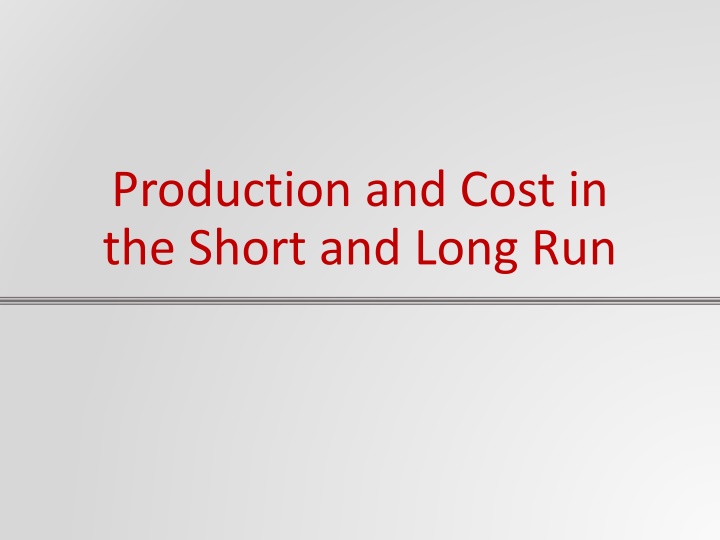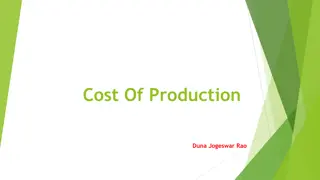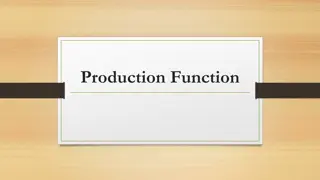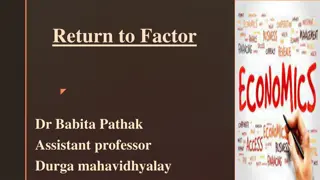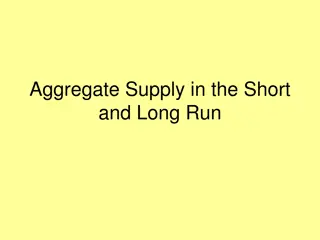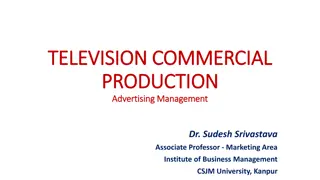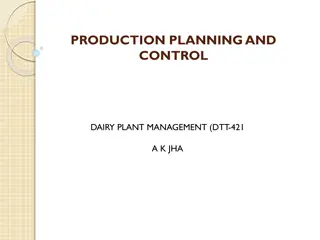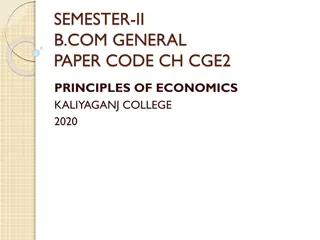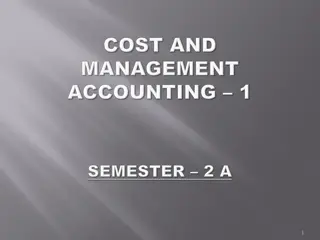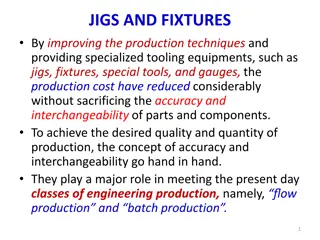Production and Cost in the Short and Long Run
This presentation delves into the concepts of production functions, marginal product, short run versus long run production, cost components, economies of scale, accounting profit versus economic profit, the theory of the firm, and the spectrum of competition in economics.
Download Presentation

Please find below an Image/Link to download the presentation.
The content on the website is provided AS IS for your information and personal use only. It may not be sold, licensed, or shared on other websites without obtaining consent from the author.If you encounter any issues during the download, it is possible that the publisher has removed the file from their server.
You are allowed to download the files provided on this website for personal or commercial use, subject to the condition that they are used lawfully. All files are the property of their respective owners.
The content on the website is provided AS IS for your information and personal use only. It may not be sold, licensed, or shared on other websites without obtaining consent from the author.
E N D
Presentation Transcript
Production and Cost in the Short and Long Run
Acknowledgments This PowerPoint presentation is based on and includes content derived from the following OER resource: Principles of Microeconomics An OpenStax book used for this course may be downloaded for free at: https://openstax.org/details/books/principles-microeconomics-2e 2
Key Questions What is the difference between accounting profit and economic profit? What is a production function? What is marginal product? What is the difference between the short run and the long run in production? What are the components of cost in the short run and the long run? What are economies of scale? 3
The Theory of the Firm Firm (or producer or business) - an organization that combines inputs of labor, capital, land, and raw or finished component materials to produce outputs. Private enterprise - the ownership of businesses by private individuals. Production - the process of combining inputs to produce outputs, ideally of a value greater than the value of the inputs. 4
The Spectrum of Competition At one extreme - perfect competition - many firms are all trying to sell identical products. At the other extreme monopoly - only one firm is selling the product, and this firm faces no competition. In between - monopolistic competition - many firms selling similar, but not identical products. Also in between - oligopoly - a few firms that sell identical or similar products. 5
Revenue and Explicit and Implicit Costs Revenue - the income a firm generates from selling its products. Total Revenue = Price x Quantity Sold Explicit costs - out-of-pocket costs; actual payments. Wages, rent, etc. Implicit costs - the opportunity cost of using resources that the firm already owns. Depreciation of goods, materials, and equipment 6
Accounting vs. Economic Profit Profit the difference between total revenue and total cost. Profit = Total Revenue Total Cost Accounting profit - the difference between total revenue and out-of-pocket costs. Accounting Profit = Total Revenue - Explicit Costs Economic profit - includes both explicit and implicit costs. Economic Profit =Total Revenue - Total Costs Total Costs = Explicit Costs + Implicit Costs 7
Production in the Short Run The production process for pizza includes inputs such as ingredients, the efforts of the pizza maker, and tools and materials for cooking and serving. (Credit: Haldean Brown/Flickr Creative Commons) 8
The Production Function Categories of factors of production (inputs) - resources that firms use to produce their products,: Natural Resources (Land and Raw Materials) Labor Capital Technology Entrepreneurship Production function - mathematical equation that tells how much output (Q) a firm can produce with given amounts of the inputs. Q = f[NR,L,K,T,E] 9
Inputs Fixed inputs (K) - factors of production that can t be easily increased or decreased in a short period of time. Variable inputs (L) - factors of production that a firm can easily increase or decrease in a short period of time. Short-hand form for the production function: Q = f [L,K] 10
Production in the Short Run vs. Long Run Short run - period of time during which at least some factors of production are fixed. Long run - period of time during which all factors are variable. 11
Example Production in the Short Run Production in the short run may be explored through the example of lumberjacks using a two-person saw. (Credit: Wknight94/Wikimedia Commons) Q = TP = f [L,K], or just Q = TP = f [L] Output (Q) is also called Total Product (TP). K is fixed in the short run so the amount of output (trees cut down per day) depends only on the amount of labor employed (number of lumberjacks working). 12
Marginal Product Marginal product (MP) - the additional output of one more worker. ?? = ?? ? Law of Diminishing Marginal Productivity - general rule that as a firm employs more labor, eventually the amount of additional output produced declines. 13
Short Run Production Function for Trees The top graph shows the short run total product for trees. As the number of lumberjacks increase, the output also increases, until 5 lumberjacks are reached. The bottom graph shows that as workers are added, the MP increases at first, but sooner or later additional workers will have decreasing marginal product. 14
General Case of Total and Marginal Product Curves General case of total product curve. General case of marginal product curve. 15
Costs in the Short Run Factor payments - what the firm pays for the use of the factors of production (costs from the firm s perspective). Raw materials prices Rent Wages and salaries Interest and dividends Profit Variable costs - costs of the variable inputs, like labor. Fixed costs - costs of the fixed inputs, like rent. Expenditure that a firm must make before production starts Do not change regardless of the level of production. Total cost - the sum of fixed and variable costs 16
Costs Average total cost (ATC) - total cost divided by the quantity of output produced. ??? =?? ? Marginal cost (MC)- the additional cost of producing one more unit of output. ?? = ?? ? Average variable cost (AVC) - variable cost divided by quantity of output. ??? =??? ? 17
How Output Effects Total Costs At zero production, the fixed costs of $160 are still present. As production increases, variable costs are added to fixed costs, and the total cost is the sum of the two. 18
Cost Curves Average total cost (ATC) Typically U-shaped Average variable cost (AVC) Lies below the average total cost curve and Typically U-shaped or upward- sloping. Marginal cost (MC) Generally upward-sloping 19
Average Profit Average Profit or profit margin = price average cost If the market price > average cost, then average profit will be positive. If price is < average cost, then profits will be negative. 20
Production in the Long Run In the long run, all factors (including capital) are variable. Production function is Q = f [L, K] Because all factors are variable, the long run production function shows the most efficient way of producing any level of output. 21
Costs in the Long Run The long run is the period of time when all costs are variable. Production technologies refer to alternative methods of combining inputs to produce output Economies of scale - the situation where, as the quantity of output goes up, the cost per unit goes down. 22
Economies of Scale A small factory like S produces 1,000 alarm clocks at an average cost of $12 per clock. A medium factory like M produces 2,000 alarm clocks at a cost of $8 per clock. A large factory like L produces 5,000 alarm clocks at a cost of $4 per clock. Economies of scale exist because the larger scale of production leads to lower average costs. 23
Shapes of Long Run Average Cost Curves Long-run average cost (LRAC) curve - shows the lowest possible average cost of production, allowing all the inputs to production to vary so that the firm is choosing its production technology. Short-run average cost (SRAC) curves - the average total cost curve in the short term; shows the total of the average fixed costs and the average variable costs. 24
From Short-Run to Long-Run Average Cost Curves The five different short-run average cost (SRAC) curves each represents a different level of fixed costs, from the low level of fixed costs at SRAC1 to the high level of fixed costs at SRAC5. Other SRAC curves, not in the diagram, lie between the ones that are shown. The long-run average cost (LRAC) curve shows the lowest cost for producing each quantity of output when fixed costs can vary, and so it is formed by the bottom edge of the family of SRAC curves. If a firm wished to produce quantity Q3, it would choose the fixed costs associated with SRAC3. 25
Ranges on the Long-run Average Cost Curve Constant returns to scale - when expanding all inputs proportionately does not change the average cost of production. Diseconomies of scale - the long-run average cost of producing each individual unit increases as total output increases. A firm or a factory can grow so large that it becomes very difficult to manage or run efficiently. 26
The Size and Number of Firms in an Industry The shape of the long-run average cost curve (LARC) has implications for: how many firms will compete in an industry whether the firms in an industry have many different sizes or if they will tend to be the same size. 27
The LARC and the Size and Number of Firms (1 of 2) Panel (a): Low-cost firms will produce at output level R. When the LRAC curve has a clear minimum point, then any firm producing a different quantity will have higher costs. In this case, a firm producing at a quantity of 10,000 will produce at a lower average cost than a firm producing 5,000 or 20,000 units. 28
The LARC and the Size and Number of Firms (2 of 2) Panel (b): Low-cost firms will produce between output levels R and S. When the LRAC curve has a flat bottom, then firms producing at any quantity along this flat bottom can compete. In this case, any firm producing a quantity between 5,000 and 20,000 can compete effectively while those producing < 5,000 or >20,000 would not. 29
